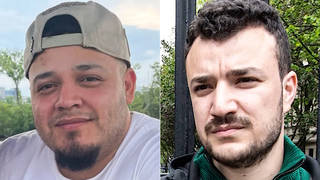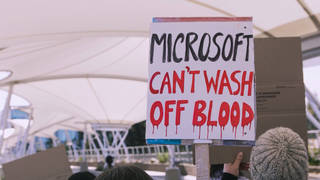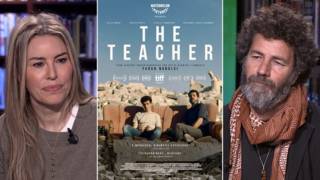
Guests
- Anand Gopalreporter and assistant research professor at Arizona State University and the author of No Good Men Among the Living. He is the co-author of The New York Times investigation into the civilian death toll of the U.S.-led war against ISIS, called “The Uncounted.”
In an extended conversation, we speak with reporter Anand Gopal about the U.S. war in Afghanistan, where the U.S. Air Force is on track to triple the number of bombs dropped this year compared with last year. The major increase in bombing comes as the Trump administration has deployed thousands more U.S. troops to Afghanistan in recent months. By early 2018, there are slated to be about 16,000 U.S. troops there. The ongoing U.S. war in Afghanistan is the longest war in U.S. history. Gopal also discusses the U.S. role in Syria. This week, Syrian President Bashar al-Assad and Russian President Vladimir Putin met for talks in Sochi, and Assad reportedly thanked Putin for “saving” Syria.
Transcript
AMY GOODMAN: This is Democracy Now!, democracynow.org, The War and Peace Report. I’m Amy Goodman, with Juan González.
JUAN GONZÁLEZ: Well, in news on the U.S. war in Afghanistan, the U.S. Air Force is on track to triple the number of bombs dropped there this year compared with last year. The major increase in bombing comes as the Trump administration has deployed thousands more U.S. troops to Afghanistan in recent months. By early 2018, there are slated to be about 16,000 U.S. troops there. The ongoing U.S. war in Afghanistan is the longest war in U.S. history.
AMY GOODMAN: For more, we speak with Anand Gopal, assistant research professor at Arizona State University and author of the book No Good Men Among the Living, which is about Afghanistan. He’s lived there for a number of years, co-author of The New York Times investigation called “The Uncounted,” which looks into the civilian death toll of the U.S.-led war against ISIS, saying it’s many times, perhaps 31 times, higher than the U.S. has admitted. But we’re shifting to Afghanistan here, where you’ve spent so much time reporting, Anand. Talk about the increased presence of the United States and what it means.
ANAND GOPAL: Well, this is probably the third or fourth major escalation of the United States in the last 15 or 16 years. And the previous three escalations have ended up in the exact same way, which is that there’s been more troops and more airstrikes, more death and devastation, and yet the same result at the end, which is the Taliban continues to hold large parts of rural areas in Afghanistan, while the Afghan government, which the U.S. is backing, is clinging to the cities and certain areas in the north.
JUAN GONZÁLEZ: And it’s repeatedly said that the United States is involved in training the Afghan military to take over security for itself. But yet all this money spent on training never seems to lead to any results in terms of increased stability in the country. Why is that?
ANAND GOPAL: Well, I mean, the Afghan forces have an extraordinarily high attrition rate. There’s a high desertion rate. And by the way, this is the best functioning institution in Afghanistan, and they have been unable to dislodge the Taliban from their strongholds. Conversely, the Taliban have been unable to dislodge the Afghan government from the major cities. And so you really have, essentially, a war of attrition. Neither side is able to defeat the other side, and the U.S. is continuing to prop up one side. So, my fear is you will essentially see a war in perpetuity.
AMY GOODMAN: You have also the increased number of bombings, on all sides. You have residents of the northern Kunduz province—this was what, in early November—saying U.S. airstrikes killed scores of civilians Friday after bombs fell on three villages west of the district capital. Residents say Afghan security forces wouldn’t allow them to access the attack sites to pick up the bodies of their relatives, making an accurate account of the death toll impossible. One provincial council member said about 55 civilians were killed, while an Afghan aid worker put the total at at least 40. The attack came two days after 15 people were killed and dozens wounded when an attack on a fuel tanker northwest of Kabul set a passenger bus on fire. No claim of responsibility in that attack. Elsewhere, the U.S. military said one soldier was killed after a battle in the eastern Logar province. The increased violence coming as the Trump administration ramps up the war in Afghanistan, again already the longest in U.S. history. So talk about all of this and what it means for the people of Afghanistan.
ANAND GOPAL: It’s just an unending tragedy. And we don’t even know how many civilians are being killed. We don’t even—I mean, there’s many attacks that actually don’t even go reported. Right now, the media presence in Afghanistan is probably the lowest point it’s been in the last 10 or 15 years. There’s just no reporting on the ground. When the previous administration—when the Obama administration was doing essentially the same thing, at least there were some reporters on the ground who could find major incidents. Right now, we don’t even have that.
AMY GOODMAN: So, what does this mean exactly, especially in light of your piece on Iraq called “The Uncounted,” where you talk about how few civilian deaths are counted? What the media intones, if they even report on what’s happening in Afghanistan, is the U.S. killed a group of militants.
ANAND GOPAL: Well, that’s right. And what we have right now in Afghanistan is essentially two sides that are more or less equally matched. And it’s going to continue that way for as long as we can foresee, which means civilians are going to continue to be caught in the middle.
The only way that can change is if, here in the United States, people realize what is being done over there in our names, that civilians are being killed. And that’s why the act of counting civilian casualties and actually being on the ground is so vitally important. And, unfortunately, we don’t have that right now in Afghanistan.
JUAN GONZÁLEZ: And the potential for a negotiated solution? I mean, there have been reports of off-and-on contacts with the Taliban to try to reach a negotiated solution. What do you make of that?
ANAND GOPAL: There have been off-and-on contacts, but the problem has been that the United States, either the Barack Obama administration or the Trump administration, has not been serious about negotiated solution. They have not been serious about peace.
And the reason for that is because they can continue this war basically in perpetuity. The political cost for the United States is very low. There’s no antiwar movement in this country. There’s no sentiment that the U.S. is there for a long time and it’s costing a massive amount of money or blood. And so, I think the calculus for the politicians has been, “We’ll just continue this basically forever, and it’s not going to be a problem.” That’s easier and safer to do than try to pursue a negotiated settlement.
AMY GOODMAN: Kunduz, that was the site of the Doctors Without Borders hospital that was—
ANAND GOPAL: That’s right, yeah.
AMY GOODMAN: —attacked by the U.S. military in 2015, and now this latest bombing in 2017.
ANAND GOPAL: And another bombing a few years earlier, where they also—NATO also bombed a fuel tanker and killed about 100, 150 civilians. So one of the tragedies is people know the names of provinces in Afghanistan by the number of civilians that have been killed in these major massacres.
AMY GOODMAN: Before we talk about Syria, I wanted to ask you one more question about Afghanistan, from TOLOnews, which said that the commander of the U.S. forces in Afghanistan, General John Nicholson, said a well-planned raid against drug-producing facilities was carried out in Helmand on Sunday and that for the first time an F-22 bomber was used in combat in Afghanistan. Talk about the significance of this and also just the massive amount of poppy and opium that’s now coming out, once again, from Afghanistan.
ANAND GOPAL: Yeah. It’s the world’s leading producer of opium. But it’s important to realize that the people who produce and sell these things are equally on the Afghan government side, that’s backed by the United States, and on the Taliban side, that what the U.S. is doing is attacking one set of drug traffickers while effectively protecting another set of drug traffickers.
And by the way, on this strike, they actually uploaded a video of this strike, similar to the strike that we described on Basim Razzo’s house. And what that should tell us is we should have a lot of skepticism with these sorts of videos. We can’t just accept that this is actually a drug production facility because the video says so.
AMY GOODMAN: And the use of the F-22?
ANAND GOPAL: Well, yeah. I mean, they’re using all sorts of things now. I mean, it’s not just a drone war. It’s all sorts of conventional aircraft. Now there’s talk about rolling out the F-35, which is the—costs hundreds of millions of dollars. And, you know, there’s all sorts of money to build new sorts of aircraft to bomb people, but not money for other basic human things.
AMY GOODMAN: So this is a bonanza for the U.S. military contractors.
ANAND GOPAL: Oh, yeah. I mean, I think that the continuation of the Afghan War is great for the Beltway bandits. It’s great for military contractors. And it’s the same in Iraq and Syria, as well.
JUAN GONZÁLEZ: Well, I’d like to switch to another topic: Syria. Syrian President Bashar al-Assad and Russian President Vladimir Putin met for talks on Monday in Sochi. During the meeting, Assad reportedly thanked Putin for “saving” Syria. So, what about the situation in Syria and the apparent total defeat of ISIS now there?
ANAND GOPAL: Well, that’s right. ISIS has been almost completely defeated because of heavy American airpower, again similar to what we’ve seen in Iraq, and also because of ground offensives by the regime forces. And what we’re seeing is that the Syrian regime is taking back parts of its territory and also crushing the initial uprising that created this whole thing back in 2011. Whether the regime will ever take back all of Syria remains to be a question, because the Kurdish forces still control 30 or 40 percent of the country.
AMY GOODMAN: And just what is happening on the ground in Syria, with the U.S., with Russia, with Syria, what you feel people are not getting information about in this country, in the United States?
ANAND GOPAL: Well, Syria no longer effectively exists as a country. It’s been de facto partitioned. There’s an American sphere of influence, there’s a Russian sphere of influence, there’s an Iranian sphere of influence, there’s a Turkish sphere of influence and a Jordanian sphere of influence. So, while the dictator, Bashar al-Assad, has maintained power, he’s effectively—he’s not really the real person in charge of all these territories. The country of Syria exists on a map. It doesn’t exist in practice.
JUAN GONZÁLEZ: Syria has become more like Beirut was—like Lebanon was in the ’70s, with different factions in control of different parts of the country, right?
ANAND GOPAL: Well, different factions controlling different parts of the country, but also that the regional powers actually control—I mean, Turkey right now is occupying parts of northern Syria. Jordanian-backed groups are in the south. The United States has dozens of bases in Syria backing the Kurdish forces. And, of course, Assad is right that he probably would have fallen if it wasn’t for Russia coming in and saving him.
AMY GOODMAN: So, can you talk about what happens now that the war on ISIS in Syria, the U.S. says, is largely concluded? How will U.S. policy change? And also, what will happen to the U.S. backing of the Kurdish troops, known as the Syrian Democratic Forces, in the north?
ANAND GOPAL: Yeah, there are two major questions moving forward in Syria. One is this one, which is, the Syrian Democratic Forces control 30 or 40 percent of the country. And the regime has stated that they want every inch of Syria back for Assad. And so, the question is whether these two forces are going to have—break out into a major war. And it’s a possibility. And I think the question depends on whether the U.S. stays there or not. And if they don’t, perhaps there will be a major conflict there.
The second major question is what happens to the rebels, the original group of fighters who rose up against the regime and tried to overthrow it. They have been concentrated in one province, called Idlib province, which now there’s a question of what’s going to be done with that province. The regime wants it back. Turkey has now invaded this province. We may be looking at a complete bloodbath, because tens of thousands of civilians have gathered there, mostly IDPs fleeing from Raqqa.
AMY GOODMAN: Internally displaced people.
ANAND GOPAL: Internally displaced people, fleeing from other areas that ISIS had controlled. They’ve all been concentrated in this one area, and there’s a real worry among Syrians there that this will just turn into a free fire zone for the regime.
AMY GOODMAN: Are there any negotiations taking place?
ANAND GOPAL: There are some negotiations. But at the end of the day, Assad has gotten what he’s wanted pretty much every step of the way. So, that’s what people fear, is that he’ll get what he wants in this province of Idlib, which is to kill every man, woman and child, until he takes back power.
ANAND GOPAL: Anand Gopal, thank you so much for being with us, assistant research professor at Arizona State University, longtime journalist, the author of No Good Men Among the Living, the book about Afghanistan, co-author with Azmat Khan of a New York Times investigation, the cover story of The New York Times Sunday magazine, that looks into the civilian death toll of the U.S.-led war against ISIS, the investigation called “The Uncounted.” And we will link to that at democracynow.org.
To see Part 1 of our conversations with both Anand Gopal and Azmat Khan, we urge you to go to democracynow.org. I’m Amy Goodman, with Juan González. Thanks so much for joining us.











Media Options